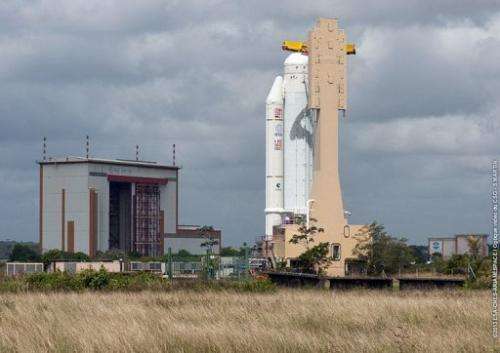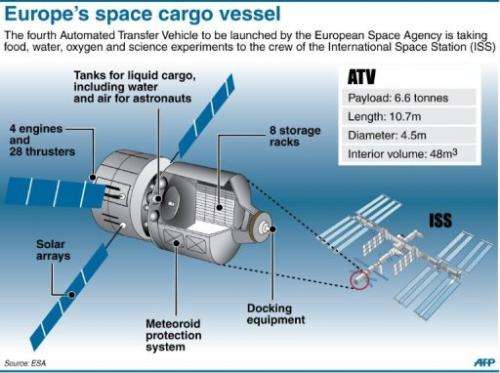The Arianespace Ariane 5 VA213 stands on the launch pad at Kourou space center, French Guiana, March 11, 2013. The fifth and mightiest generation of Ariane rockets is set to take a whopping 20.2 tonnes into orbit on June 5, 2013, in a cargo craft the size of a double-decker bus and a record for Europe.
Nearly 40 years ago, European countries worried by US and Soviet dominance of space gave the green light to the first Ariane rocket, a wee launcher capable of hoisting a satellite payload of just 1.8 tonnes—the equivalent mass of two small cars.
On Wednesday, the fifth and mightiest generation of Arianes is set to take a whopping 20.2 tonnes into orbit, a cargo craft the size of a double-decker bus and a record for Europe, proud engineers say.
The payload is the fourth cargo delivery by the European Space Agency (ESA) to the International Space Station (ISS), bringing food, water, oxygen, scientific experiments and special treats to the orbiting crew.
An Ariane 5 ES is scheduled to blast off from ESA's base at Kourou in French Guiana at 6:52 pm (2152 GMT) Wednesday, taking aloft an Automated Transfer Vehicle (ATV), a robot space truck dubbed the Albert Einstein.
The cargo craft will carry almost seven tonnes of dry and fluid cargo for its five-month mission.
About an hour after liftoff, somewhere over New Zealand, the ATV, some 10 metres (33 feet) long, will detach from the rocket's upper stage and then deploy its four energy-generating solar panels and navigate autonomously, guided by starlight, to the space station.
It will dock with the ISS on July 15 at an altitude of about 400 kilometres (250 miles) above the planet.
Graphic factfile on the ATV space freighter, the biggest of its kind
"By then it has a velocity of 28,000 kilometres (18,000 miles) per hour, and has to fly to a destination (the docking mechanism) about 60 cm (23 inches) in width," said Bart Reijnen, head of orbital systems at the Astrium space company which built the lifeline craft.
"It has to fly there fully autonomously and dock with this target of 60 cm with a precision of six cm (2.4 inches). That is something that might be difficult to imagine."
The craft has enough fuel to make three docking attempts if something were to go wrong during the final approach, said Jean-Michel Bois, ATV operations manager in Toulouse, France, from where the vessel's flight path will be monitored.
In the case of a failed attempt, the ATV would retreat from the ISS and go into a different orbit, returning two days later to try again.
This has never happened, said Bois, adding: "I cross my fingers."
The Albert Einstein will boast the largest assortment of goods yet delivered to the ISS—a total of 1,400 individual items that include everything from pyjamas and toothbrushes to peanut butter, lasagne and tiramisu for its six astronauts.
Apart from several months' worth of food, the craft carries 4.8 tonnes of fuel needed to dock with the ISS and give it a boost into higher orbit with its onboard engines.
This is necessary because the ISS is in a low Earth orbit and encounters atmospheric resistance which causes it to fall towards our planet at a rate of about 100m (300 feet) per day.
ATVs can also push the ISS out of the way of oncoming space debris.
ESA is contracted to provide five ATVs as its contribution to the ISS, a US-led international collaboration.
The three previous missions have performed flawlessly, muting criticism of the billion-euro ($1.3-billion) development cost.
The Albert Einstein will carry 800 kg (1,760 pounds) of propellant to be pumped into the ISS itself, as well as more than 500 kilos (1,100 pounds) of water and 100 kilos of oxygen, according to Astrium.
And it will bring a scientific experiment designed to test the behaviour of emulsions—a mixture of liquids that do not blend, like mayonnaise—in weightless conditions.
The ATV's pressurised cabin will provide welcome extra space for the ISS crew—Americans Chris Cassidy and Karen Nyberg, Russians Fyodor Yurchikhin, Pavel Vinogradov and Alexander Misurkin, and Italian Luca Parmitano.
After completing its mission, the ATV-4 will undock from the ISS filled with about six tonnes of garbage and human waste, and burn up over the Pacific.
A brief history of Europe's ISS cargo programme
The European Space Agency's Albert Einstein cargo craft, set for launch on Wednesday, is the fourth and penultimate in a series of hi-tech lifeline vessels bringing supplies and critical altitude boosts to the International Space Station.
Europe's Automated Transfer Vehicles (ATVs), blasted into space by ESA's Ariane rocket, are the biggest cargo carriers to the ISS since the retirement of the US space shuttle in 2011.
ESA sends an ATV to the orbiting outpost about once every 17 months with around six tonnes of cargo—much of it fuel needed to boost the ISS, which is constantly falling towards Earth due to atmospheric resistance.
Named in honour of the father of relativity theory, the Albert Einstein follows the hi-tech trail of three others since 2008 that also carried the names of science gurus—the Jules Verne, the Johannes Kepler and the Edoardo Amaldi.
It will be followed next year by the last in the ATV series—the George Lamaitre named for the father of the Big Bang theory of the Universe's creation.
At 20.2 tonnes, the ATV-4 is the heaviest yet launched and will bring a record 2.5 tonnes of dry cargo to the six-member space station crew.
ATV-1: Jules Verne (2008)
The first in the series carried a total load of 4.5 tonnes consisting of 3.4 tonnes of fluid and 1.1 tonnes of dry supplies.
The payload heavily favoured propulsion fuel, including enough reserves in case of unforeseen problems with this first-ever ATV docking to the ISS.
The Jules Verne had no late load—that part of the cargo nowadays reserved for last-minute requests and perishables whose packing poses great technical difficulties once the capsule is perched vertically on top of the Ariane rocket that will propel it into space. The loading hatch is right on the vessel's nose—about 10 storeys high.
ATV-2: Johannes Keppler (2011)
This vessel holds the record for the largest boost given to the ISS by an ATV—40 kilometres in a single push.
It also holds the record for the heaviest cargo ever delivered to the outpost—over seven tonnes, though the ATV-4 will have more dry cargo.
The Johannes Keppler took 1.6 tonnes of dry supplies and 5.4 tonnes of fluid cargo, and a big supply of fuel that was used for the special orbital boost.
This was the last ATV not to bring water to the ISS—a task until this point performed by the US space shuttles which had also been responsible for boosting the space station's altitude.
ATV-3: Edoardo Amaldi (2012)
The third ATV carried 4.3 tonnes of fluid cargo and 2.2 tonnes of dry supplies.
As the technology and confidence grew with each successive mission, the ATVs started favouring a balance of more cargo and less backup fuel.
ATV-4: Albert Einstein (2013)
Will carry 4.1 tones of fluid and 2.5 tonnes of dry cargo—6.6 tonnes in total.
It boasts the most complex flight software ever developed by ESA—a million lines of code.
It has the biggest-ever late cargo load, exceeding its nearest rival by more than 218 kg thanks to a new device that can lower an operator deep into the hull to load the holding racks, aided by a mechanical arm that can hold bags weighing as much as 75 kg each.
The Albert Einstein has the largest-ever assortment of goods taken into space, some 1,400 individual items.
The launch of ATV-5, the George Lemaitre, next year, will not mean the end of ESA's ATV programme.
The European agency will supply ATV-derived hardware for NASA's Orion spacecraft being designed to take humans to the Moon and beyond, and scheduled for a test flight in 2017.
This will be the first collaboration between ESA and NASA on a crew transport vehicle.
© 2013 AFP
























